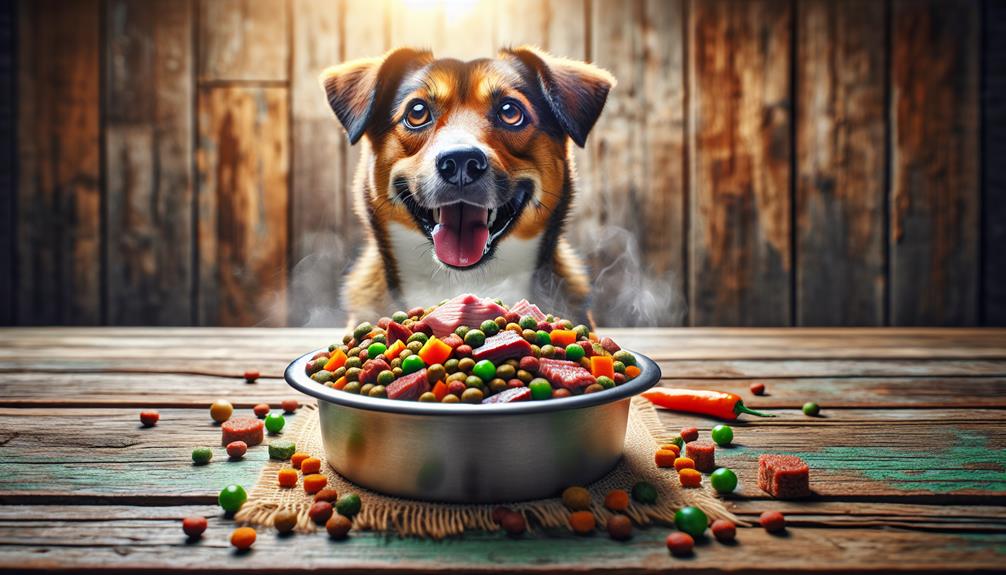In exploring the benefits of serving freshly prepared hot dog meals, one must consider the extensive impact on a pet’s health and the strengthening of the pet-owner bond. These meals, customized to meet the specific dietary needs and health conditions of each dog, not only guarantee a balanced intake of essential nutrients but also enhance the meal’s attractiveness, potentially leading to improved eating habits. Besides, the process of preparing and serving warm meals can greatly deepen the emotional connection between the pet and the owner. As we unravel the layers of advantages, the question arises: could this approach redefine our conventional feeding techniques? Curious about enhancing your dog’s health and your bond? Discover why serving freshly cooked warm meals might be the game changer.
Key Takeaways
- Freshly cooked warm meals enhance nutrient absorption and digestion in dogs.
- Warm meals are tailored to meet specific dietary needs and health conditions.
- Serving warm food increases palatability and hydration, encouraging a healthy appetite.
- Fresh meals can strengthen the emotional bond between owner and dog through nurturing behaviors.
- Investing in fresh, warm meals can lead to long-term health benefits and lower veterinary costs.
Enhancing Nutritional Value

Enhancing the nutritional value of warm dog meals involves carefully selecting high-quality proteins, vitamins, and minerals to support overall health and well-being. When meals are served warm, it can increase palatability, enticing even the pickiest eaters. This aids not only in maintaining a healthy appetite but also ensures that the nutritional content is fully appreciated and utilized by the dog’s body.
Customized portions play an essential role in this scenario. By tailoring meal sizes and nutrient ratios to the specific needs of each dog, based on factors such as age, weight, and activity level, owners can prevent overfeeding and undernutrition. This customization supports enhanced nutrient absorption, as the digestive system can process well-proportioned meals more efficiently, maximizing the benefit of each nutrient.
Furthermore, serving warm meals can lead to enhanced hydration, as dogs may find warm, moist food more appealing than dry kibble, and often, these meals contain a higher moisture content.
Additionally, the careful selection of ingredients can help in reducing food allergies. By avoiding common allergens and using hypoallergenic ingredients, warm meals can be crafted to alleviate allergic reactions and promote a healthier immune response, creating a more inclusive and safe eating environment for all dogs.
Tailoring for Dietary Needs

Addressing specific dietary needs, tailoring warm dog meals involves incorporating specialized ingredients and adjusting nutrient profiles to meet individual health conditions and life stages. By designing customized recipes, we can cater to the unique needs of each canine, whether they require low-fat diets for weight management or higher protein content to support muscular health. This customization not only ensures that dogs with specific dietary restrictions receive the nutrition they need but also promotes overall health and wellbeing.
Specialized diets provide targeted health benefits. For instance, for dogs with kidney issues, reducing phosphorus intake is essential, and this can be achieved by selecting specific cooking techniques and ingredients that lower phosphorus levels without compromising on taste or nutritional value. Similarly, dogs with sensitive stomachs may benefit from meals that include easily digestible proteins and carbohydrates, carefully selected through meticulous cooking processes.
Moreover, offering a variety of meals prevents dietary monotony, encouraging dogs to eat consistently and heartily. By varying ingredients and employing different cooking techniques, each meal can be a unique, appealing, and nutritious experience for the dog. This approach not only nurtures their physical health but also enhances their emotional connection with food, fostering a sense of belonging and contentment.
Improving Digestibility

Improving the digestibility of warm dog meals involves carefully selecting and preparing ingredients that are easier for dogs to break down and absorb. Enhanced digestibility is vital for maintaining peak digestive health and guaranteeing that dogs receive the full nutritional benefits of their meals.
Here are some key considerations for improving the digestibility of dog meals:
- Ingredient Quality: Select high-quality, easily digestible proteins and carbohydrates. Fresh meats and whole grains are preferable, as they are less likely to cause digestive upset compared to processed or low-quality alternatives.
- Temperature Benefits: Serving meals warm can help increase enzyme activity, which aids in the breakdown of food. Warmth can also enhance the aroma and flavor of the meal, catering to dogs’ flavor preferences and motivating them to eat with enthusiasm.
- Consistency Advantages: Pureeing or lightly processing the ingredients can make them easier for dogs to chew and digest, especially for younger or older dogs with sensitive digestive systems.
- Balanced Compositions: Ensure that meals are nutritionally balanced with the right proportions of fiber, fats, and proteins, which contribute to smoother digestion and better nutrient absorption.
Strengthening Emotional Bonds

Serving warm dog meals not only nurtures their physical health but also strengthens emotional bonds between pets and their owners. Engaging in bonding activities such as preparing and sharing a warm meal notably enhances the quality time spent together, fostering a deeper emotional connection. This practice isn’t just about feeding but is an act of care and love that resonates with dogs, who are naturally pack animals and value shared experiences.
Scientific studies suggest that dogs are more likely to develop a stronger bond with those who regularly engage in trust-building exercises with them. The act of serving warm food can be viewed as an exercise because it requires patience, understanding, and attention to the dog’s dietary needs, which are essential in demonstrating trust and security from the owner to the pet. This nurturing behavior is recognized by dogs, reinforcing their trust and loyalty.
Moreover, the warmth of the meal may mimic the natural body warmth of a mother, making the food not just more appealing but also more comforting, thereby enhancing the sense of safety and belonging.
This routine can notably elevate the overall happiness and well-being of dogs, ensuring that they feel not only physically nourished but also emotionally supported.
Comparing Warm Meals to Kibble

When comparing freshly cooked warm meals to traditional kibble, it is evident that warm meals can provide superior nutritional benefits and enhanced digestibility for dogs. The fresh ingredients often used in home-cooked diets can bolster a dog’s health and overall well-being.
Here are four key points of comparison:
- Convenience vs. Nutrition:
While kibble offers unparalleled convenience, being ready to serve with minimal preparation time, freshly cooked meals triumph in nutritional value. These meals are typically free from preservatives and can be tailored to a dog’s specific dietary needs, providing a balance of proteins, carbohydrates, and essential vitamins that are sometimes lost in the processing of kibble. - Cost Comparison:
Initial glance might suggest that kibble is more cost-effective. However, investing in fresh meals can reduce future veterinary bills by boosting your dog’s health through diet. - Taste Preference:
Dogs generally show a preference for the variety and freshness of home-cooked meals over dry kibble, which can enhance their appetite and enjoyment of food. - Health Benefits and Cooking Time:
The health benefits of warm meals include better weight management and improved coat condition. Although the cooking time is longer than the mere preparation of kibble, the long-term health benefits for your dog are compelling.
Choosing between kibble and warm meals involves weighing these factors to decide what is best for your furry friend.
Frequently Asked Questions
How Do Warm Meals Affect a Dog’s Dental Health?
Warm meals served at best temperatures can enhance a dog’s dental hygiene by softening food, thereby reducing dental abrasions. This feeding method also caters to breed preferences and improves digestion and behavior.
Can Warm Meals Aid in Weight Management for Dogs?
Warm meals can aid in weight management for dogs, enhancing nutrient absorption and metabolism, promoting better digestive benefits, allowing improved portion control, and maintaining best energy levels for healthy and active lifestyles.
Are There Breed-Specific Benefits to Serving Warm Meals?
Serving warm meals can provide breed-specific advantages, enhancing nutritional uptake, digestive health, and energy levels, while also improving coat health and overall well-being, fostering a sense of belonging and care within the pet community.
Is There an Optimal Temperature for Serving Dog Meals?
Best temperatures for dog meals improve digestive benefits, nutrient absorption, and energy levels. Tailoring meals to your dog’s taste preference and ensuring proper hydration can greatly boost their overall health and well-being.
How Does the Frequency of Feeding Warm Meals Impact Behavior?
Frequent feeding of warm meals, like a comforting blanket, can enhance behavioral changes, stabilize energy levels, and improve digestive health. It boosts mealtime excitement and aids in better appetite control among dogs.
Conclusion
To wrap up, freshly prepared warm dog meals serve as a nutritional lighthouse, guiding canines toward a healthier horizon. By enhancing the bioavailability of nutrients, accommodating specific dietary requirements, and promoting efficient digestion, these meals prove superior to traditional kibble.
Moreover, they strengthen the emotional bond between pet and caregiver, creating a nurturing feeding experience. Embracing this dietary approach not only addresses the physiological needs of dogs but also enhances their overall quality of life.



